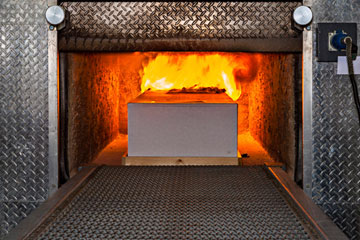
A body in the fire-based crematory oven of Lakewood Cemetery.
(2 of 8)
If we are gaining options in death, we may be losing something too, in what we leave for the living. "Throughout history, we have not only stopped and celebrated people's lives, but we've tried to create a permanent memorial so that they'll be remembered," says Mark Musgrove, funeral director at Musgrove Family Mortuary in Eugene, Ore. "And I think we may now have a whole generation of people where there's no permanent remembrance of that person."
Rise of the Ashes
When cremation historian Jason Engler was 12, his grandmother would take him to funeral homes. To hang out. On the weekends. He did his homework there. "I would do visitations and ride with the guy to the cemetery in the flower car, or I would vacuum the floors after the services," Engler says. "I was doing whatever I could to get my foot in the door."
Little Jason Engler wanted to become a funeral director. He loved learning about the lives of people who came before him. Those in the business tried to talk him out of it. But Engler never wavered. Today at 33, he sounds just as fascinated by the business of death as he was in childhood. He has also become a devoted proponent of cremation.
"It's almost a religion for those of us who believe in it," says Engler, who is the funeral director at Rollins Funeral Home in northwest Arkansas. "And for the early cremationists, it was a way of life."
Cremation appears to be as old as traditional burial. The ancient Greeks practiced it. The Romans practiced it. The Native Americans practiced it. But it wasn't until the late 19th century that modern cremation took root in the U.S. It began in tiny, quiet Washington, Pa., where an eccentric doctor named Francis LeMoyne built the first modern crematory in the U.S. in 1876 after hearing about its use in Europe. At the time, people believed they were getting sick just from attending funerals. Decomposing bodies were leaking into water systems. Death, it was believed, was contributing to even more death. So LeMoyne constructed a contraption to cremate bodies in a controlled environment primarily for sanitary reasons. This wasn't a crude funeral pyre. It was a hygienic process meant to destroy any organic matter that might cause illness and give families a more efficient way to preserve ashes. LeMoyne built the crematory for his own use--meaning he was eventually going in--but the idea was popular enough in his community that 42 cremations were performed there before it closed in 1901.
Nationally, however, this new way to dispose of bodies largely stagnated. Crematories were built at a rate of one a year in the late 19th century, and it essentially remained an unorthodox option for those who didn't want a traditional burial. As embalming became commonplace in the early 20th century, even the sanitary rationale lost its sway. "People started thinking, You can be embalmed and that'll be fine," says Engler. "So cremationists became interested in finding some other way to promote their method of disposition. And that was to make it beautiful."
